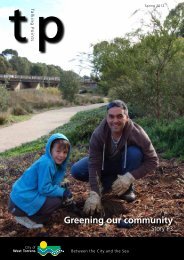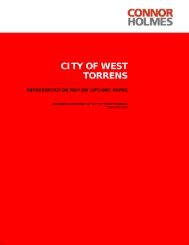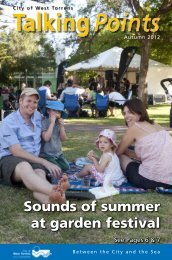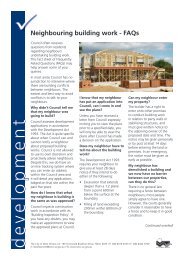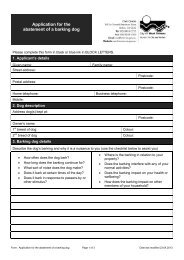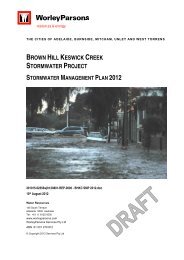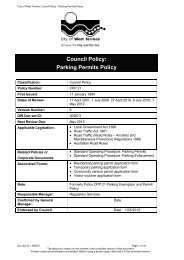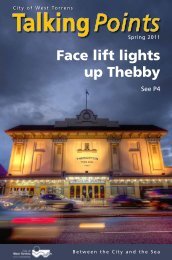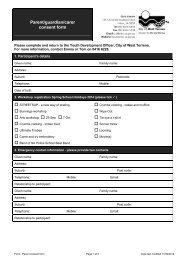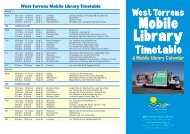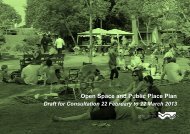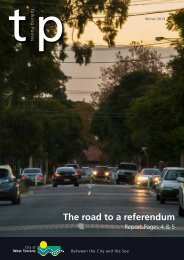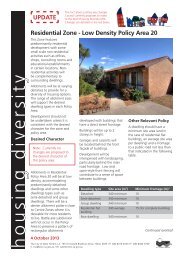Recommendations - City of West Torrens - SA.Gov.au
Recommendations - City of West Torrens - SA.Gov.au
Recommendations - City of West Torrens - SA.Gov.au
You also want an ePaper? Increase the reach of your titles
YUMPU automatically turns print PDFs into web optimized ePapers that Google loves.
Being located in close proximity<br />
to the <strong>City</strong> <strong>of</strong> Adelaide, there are<br />
many convenient public transport<br />
routes between the <strong>City</strong> <strong>of</strong> <strong>West</strong><br />
<strong>Torrens</strong> and the <strong>City</strong> <strong>of</strong> Adelaide and<br />
the beachside suburbs.<br />
In Adelaide, public transport carries<br />
an estimated 10% <strong>of</strong> passenger travel<br />
during peak hours and only 5% <strong>of</strong><br />
all weekday travel (peak and <strong>of</strong>fpeak).<br />
South Australia’s Strategic Plan<br />
identifies a target to double the use <strong>of</strong><br />
public transport to 10% <strong>of</strong> weekday<br />
travel by 2018*.<br />
* Source <strong>of</strong> information: Adelaide Urban<br />
Corridors Strategy 2006 DTRS and DTEI.<br />
The ABS Census 2001 data shows that<br />
in the <strong>City</strong> <strong>of</strong> <strong>West</strong> <strong>Torrens</strong>, 8.1% use<br />
public transport.<br />
Figure 8 shows the public transport<br />
routes located within the <strong>City</strong>.<br />
On the main east-west routes, there<br />
are Go Zones for peak hour travel<br />
along Henley Beach Road, Sir Donald<br />
Bradman Drive and Anzac Highway.<br />
The Adelaide-Glenelg tram also<br />
provides a convenient public transport<br />
service between the <strong>City</strong> <strong>of</strong> Adelaide<br />
and the beachside suburb <strong>of</strong> Glenelg.<br />
In recent years, the public transport<br />
routes have extended into the<br />
Adelaide Airport.<br />
Public Transport Routes<br />
The above map shows that the <strong>City</strong> <strong>of</strong><br />
<strong>West</strong> <strong>Torrens</strong> is well served by public<br />
transport.<br />
Travel Demand Management measures<br />
to encourage more public transport<br />
usage includes transit lanes, real<br />
time bus information, Go Zones and<br />
improvements to intersection operations.<br />
The role <strong>of</strong> the <strong>City</strong> includes providing<br />
supporting infrastructure to assist in<br />
increasing usage <strong>of</strong> public transport,<br />
for example, by providing a good<br />
network <strong>of</strong> footpaths (compliant with<br />
DDA requirements), a convenient<br />
network <strong>of</strong> bus stops and bus shelters.<br />
Increasing the public transport usage is<br />
consistent with the Infrastructure Plan<br />
for South Australia and the need to<br />
reduce greenhouse gas emissions by<br />
reducing car usage.<br />
Where public transport routes utilise<br />
local streets, a number <strong>of</strong> issues have<br />
arisen in recent years, in particular the<br />
need to design traffic control devices<br />
to accommodate the infrequent<br />
articulated bus and the increasing<br />
use <strong>of</strong> 14.4m long controlled access<br />
rigid buses.<br />
The design <strong>of</strong> traffic control devices<br />
on local streets which form part <strong>of</strong><br />
a regular bus route need to have<br />
regard to the type <strong>of</strong> buses that would<br />
traverse the device. The frequent<br />
constrained width <strong>of</strong> local intersections<br />
means that articulated buses are <strong>of</strong>ten<br />
not possible to be accommodated. If<br />
mounting <strong>of</strong> the central island were<br />
possible, the design <strong>of</strong> a roundabout<br />
would be much easier. However,<br />
DTEI has, in the past, not accepted<br />
such an approach.<br />
Figure 8<br />
Public transport routes: source DTEI<br />
48<br />
Part 1 - Overview | Public Transport<br />
The increasing use <strong>of</strong> the 14.4m<br />
long controlled access bus means<br />
that it would become even more<br />
difficult to accommodate such a bus<br />
in the design <strong>of</strong> roundabouts, given<br />
the longer wheel base and turning<br />
space requirements. For existing<br />
roundabouts, it would be likely that



